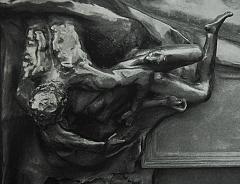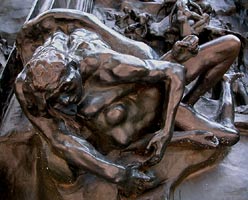|
 Between
1898 and 1900, Rodin added a third version 'The
Falling Man' to his monumental 'Gates of
Hell': in 'Avarice and Lust', the upper half of 'The
Falling Man' is stretching his muscle-packed arms across a lying
woman. Although the calmess of her averted face suggests she is asleep,
her spread thighs and stiff arms contradict any impression of relaxation.
The two characters cannot see each others faces and in the final version
of 'The Gates', the groping giant does not even really touch this partner,
still the whole composition transmits a mood of breathless sexual tension:
an irritating combination of insatiable greed and strained surrender.Audeh suggests the groups represents two of the seven primary sins as
condemned by Catholic religion, whereby Avarice ist mostly attributed to
men, and Lust to women. In Canto VII of the Divina Commedia, Dante
is confronted with the Avaricious, clutching to their possessions. Between
1898 and 1900, Rodin added a third version 'The
Falling Man' to his monumental 'Gates of
Hell': in 'Avarice and Lust', the upper half of 'The
Falling Man' is stretching his muscle-packed arms across a lying
woman. Although the calmess of her averted face suggests she is asleep,
her spread thighs and stiff arms contradict any impression of relaxation.
The two characters cannot see each others faces and in the final version
of 'The Gates', the groping giant does not even really touch this partner,
still the whole composition transmits a mood of breathless sexual tension:
an irritating combination of insatiable greed and strained surrender.Audeh suggests the groups represents two of the seven primary sins as
condemned by Catholic religion, whereby Avarice ist mostly attributed to
men, and Lust to women. In Canto VII of the Divina Commedia, Dante
is confronted with the Avaricious, clutching to their possessions.
 The
group is located at the lower left corner of the right wing. 'The
Falling Man' itself is positioned at the top of the left door,
grabbing the lintel above it; the combination 'I
am Beautiful' is part of the bas-relief at the extreme right side of
the portal. All three male
bodies are based on a study of the strong man Cailloux, who also posed for
'The Shade' and possibly for 'Adam'. Accounting for
his threefold appearance in 'The Three Shades',
this same model has been represented at least six times 'The Gates'. The
group is located at the lower left corner of the right wing. 'The
Falling Man' itself is positioned at the top of the left door,
grabbing the lintel above it; the combination 'I
am Beautiful' is part of the bas-relief at the extreme right side of
the portal. All three male
bodies are based on a study of the strong man Cailloux, who also posed for
'The Shade' and possibly for 'Adam'. Accounting for
his threefold appearance in 'The Three Shades',
this same model has been represented at least six times 'The Gates'.
As can be easily seen, in 'Avarice and Lust' the male
character is cut off at the waist; he seems to emerge from the mass of the
door, the plasmatic substance that could represent either fire, water,
earth or wind, according to the context the figures needed. Although the
work was also exhibited and eventually cast in bronze an autonomous work -
the couple facing forward, instead of downward as seen in 'The Gates', - Rodin never thought it
necessary to complement the man's upper body - other than in the case of 'Fugit
Amor', for which he completed Paolo's legs so that the love couple
could be presented as a freestanding sculpture.
|

 The
group is located at the lower left corner of the right wing.
The
group is located at the lower left corner of the right wing.